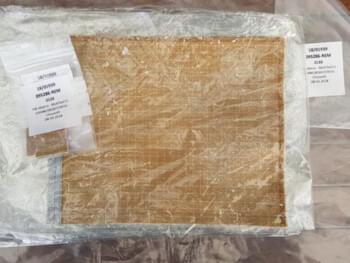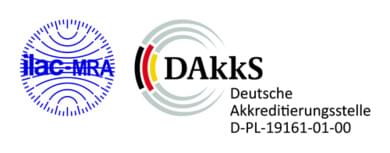Test method developed for asbestos decontamination of firefighters' clothing
In fire situations, firefighters are exposed to a variety of hazardous substances, including asbestos. The increasing sensitivity in emergency hygiene - especially in the case of heavily contaminated emergency clothing - raises various questions:
- How and to what extent can firefighters' clothing contaminated with asbestos be cleaned at all?
- Is the washing process of a special laundry in principle able to remove asbestos contamination from typical materials of the clothing?
- Do the types of fabric used to manufacture casual wear allow for a higher cleaning performance than other types of fabric, such as cotton?
So far, there is a lack of standardized test procedures for assessing the cleaning performance of washing processes. In cooperation with the MeyerundKuhl specialist laundry, our accredited asbestos laboratory has therefore developed a test procedure and applied it on the basis of a series of tests in order to make a qualitative statement and quantify the cleaning performance possible.
Aim of the developed test method
The jointly developed test procedure is used to check whether fire-fighting textiles can be sufficiently decontaminated by washing and impregnation. Various textile materials that are common for the manufacture of personal protective equipment, such as Nomex, PBI or X55, are tested. The aim is to investigate whether the type of fabric has an influence on the cleaning effect. It will also be analyzed whether these special textile fabrics are better suited for decontamination in a laundry than comparable cotton or synthetic fabrics.
For realistic test conditions, the instructions for use hygiene in fire fighting are applied. In addition, the test fabrics are washed together with standard firefighting clothing in order to achieve the same mechanical loads that arise in a special laundry as a result of the washing and impregnation process.
Since there are no official limits, this test method can only be used to assess the effectiveness of the washing process by comparing the fibre concentrations before and after the washing process.
Procedure for testing asbestos decontamination
 The analysis of the contamination before and after the washing process methodically follows the guideline VDI 3866, Part 5, Appendix B:2017-06, which is relevant in Germany for asbestos tests, in which even the smallest asbestos contents can be detected with a detection sensitivity of 0.001 mass percent asbestos.
The analysis of the contamination before and after the washing process methodically follows the guideline VDI 3866, Part 5, Appendix B:2017-06, which is relevant in Germany for asbestos tests, in which even the smallest asbestos contents can be detected with a detection sensitivity of 0.001 mass percent asbestos.
The individual steps at a glance:
- Cutting of 3 pieces of fabric each 15 cm x 15 cm for each type of textile examined (Nomex, PBI and X55 as well as a simple cotton fabric)
- Providing the fabric pieces with a permanent label for unambiguous identification
- Contamination of fabric samples in the laboratory with the two most common types of technical asbestos, chrysotile and amosite, and individual packaging in airtight, water-soluble bags
- Washing of the test substances in the special laundry together with other textile garments
- Water samples are taken from the wash liquor after the first wash and at the end of the washing and impregnation process
- Analysis of the water samples and the purified test substances in the analysis laboratory for asbestos fibres and residual fibre contents
Investigation results: Chrysotile asbestos can be completely removed from fire brigade clothing through special cleaning
Within the scope of the investigation carried out jointly with the MeyerundKuhl special laundry, the concentrations of impurities in the fabric samples prior to the washing process were significantly high. If there is a similar contamination situation due to a fire with asbestos, a health hazard can clearly be assumed. Textiles contaminated in this way should only be subjected to further treatment by trained persons with special hygiene procedures.
Important results of the test procedure for asbestos decontamination
- Even small amounts of asbestos are sufficient to cause considerable contamination of textiles.
- Chrysotile asbestos could not be detected in any of the fabric samples after washing.
- After washing, individual isolated fibres or small fibre bundles of amositic asbestos were detected in all the contaminated fabric samples examined.
- Fabrics (PBI, X55 and NOMEX) used especially for casual wear are much easier to clean than conventional cotton.
The washing process developed in the MeyerundKuhl special laundry is suitable for removing significant amounts of asbestos from the main types of fabric used in firefighting clothing. The most frequently used technical asbestos mineral, chrysotile, can apparently be completely removed by a suitable washing process. Depending on the type of textile, the fibre load caused by amosite can be reduced by 99.4 % (cotton) to 99.9 % (Nomex). The residual contamination can be explained by the fact that the needle-shaped, bulky amosite fibres drill deep into the fabric and interlock so that they cannot be quantitatively extracted by the washing process. However, it is not to be expected that these fibres will be released from the fabric during further use of the textiles and lead to a risk to humans and the environment.
The jointly developed test procedure appears to be suitable for demonstrating the effects of special cleaning in connection with fibre-related contamination. In addition to pure casual wear, protective helmets, respiratory protection, gloves and boots must also be included in the decontamination concept. Further test series could also test the assumption that contaminated cotton is difficult to clean and is therefore not suitable for applications in which persons are exposed to the contamination of fibre-related substances.
Further information on the developed test procedure for the washing performance/decontamination of fire brigade textiles under asbestos exposure can be found in this paper by Ralf Klaus Blecher, Dr. Jochen Kuhl, Axel Meyer and Dr. Stefan Pierdzig:
Decontamination of fire brigade textiles during asbestos exposure (PDF, 2,1 MB)


